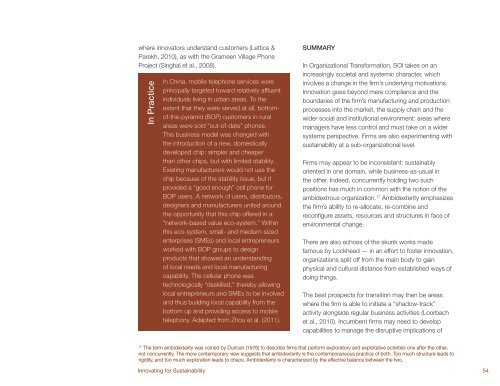Systematic Review - Network for Business Sustainability
Systematic Review - Network for Business Sustainability
Systematic Review - Network for Business Sustainability
Create successful ePaper yourself
Turn your PDF publications into a flip-book with our unique Google optimized e-Paper software.
where innovators understand customers (Lettice &<br />
Parekh, 2010), as with the Grameen Village Phone<br />
Project (Singhal et al., 2008).<br />
In Practice<br />
In China, mobile telephone services were<br />
principally targeted toward relatively affluent<br />
individuals living in urban areas. To the<br />
extent that they were served at all, bottomof-the-pyramid<br />
(BOP) customers in rural<br />
areas were sold “out-of-date” phones.<br />
This business model was changed with<br />
the introduction of a new, domestically<br />
developed chip: simpler and cheaper<br />
than other chips, but with limited stability.<br />
Existing manufacturers would not use the<br />
chip because of the stability issue, but it<br />
provided a “good enough” cell phone <strong>for</strong><br />
BOP users. A network of users, distributors,<br />
designers and manufacturers united around<br />
the opportunity that this chip offered in a<br />
“network-based value eco-system.” Within<br />
this eco-system, small- and medium-sized<br />
enterprises (SMEs) and local entrepreneurs<br />
worked with BOP groups to design<br />
products that showed an understanding<br />
of local needs and local manufacturing<br />
capability. The cellular phone was<br />
technologically “deskilled,” thereby allowing<br />
local entrepreneurs and SMEs to be involved<br />
and thus building local capability from the<br />
bottom up and providing access to mobile<br />
telephony. Adapted from Zhou et al. (2011).<br />
SUMMARY<br />
In Organizational Trans<strong>for</strong>mation, SOI takes on an<br />
increasingly societal and systemic character, which<br />
involves a change in the firm’s underlying motivations.<br />
Innovation goes beyond mere compliance and the<br />
boundaries of the firm’s manufacturing and production<br />
processes into the market, the supply chain and the<br />
wider social and institutional environment: areas where<br />
managers have less control and must take on a wider<br />
systems perspective. Firms are also experimenting with<br />
sustainability at a sub-organizational level.<br />
Firms may appear to be inconsistent: sustainably<br />
oriented in one domain, while business-as-usual in<br />
the other. Indeed, concurrently holding two such<br />
positions has much in common with the notion of the<br />
ambidextrous organization. 17 Ambidexterity emphasizes<br />
the firm’s ability to re-allocate, re-combine and<br />
reconfigure assets, resources and structures in face of<br />
environmental change.<br />
There are also echoes of the skunk works made<br />
famous by Lockheed — in an ef<strong>for</strong>t to foster innovation,<br />
organizations split off from the main body to gain<br />
physical and cultural distance from established ways of<br />
doing things.<br />
The best prospects <strong>for</strong> transition may then be areas<br />
where the firm is able to initiate a “shadow-track”<br />
activity alongside regular business activities (Loorbach<br />
et al., 2010). Incumbent firms may need to develop<br />
capabilities to manage the disruptive implications of<br />
17 The term ambidexterity was coined by Duncan (1976) to describe firms that per<strong>for</strong>m exploratory and exploitative activities one after the other,<br />
not concurrently. The more contemporary view suggests that ambidexterity is the contemporaneous practice of both. Too much structure leads to<br />
rigidity, and too much exploration leads to chaos. Ambidexterity is characterized by the effective balance between the two.<br />
Innovating <strong>for</strong> <strong>Sustainability</strong> 54
















